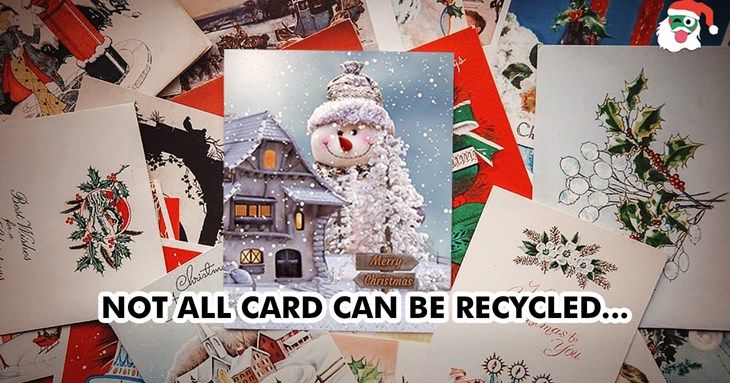We don’t want cards – including Christmas cards – in your green bin
Published: 10 December 2021

Everyone knows that glittery and metallic greetings cards can’t be recycled, right?
Well, it may come as a shock to you that even ‘plain’ greetings cards are very hard to recycle.
In fact, here in Exeter we don’t want greetings cards – including Christmas cards – in your green bin at all.
Here’s why.
As with many things in the world of waste, recycling fibre products (card and paper) isn’t as straightforward as it would seem. Digging a little deeper into the situation reveals layers of complexity.
While glitter and foil are obviously to be avoided – contaminating entire paper loads and rendering them near useless – you could be forgiven for wondering why ‘normal’ cards don’t make the cut.
Well, firstly there’s the quality of the card itself.
When you consider that greetings cards are produced very cheaply in their millions, it’s perhaps easier to accept that they are not of a sufficient quality to recycle along with the higher-grade cardboard Exeter receives without diluting the quality of that material.
Dilute the quality of the material and you limit the potential for it to be recycled into good quality products. In short, cards make very recyclable material into not very recyclable material.
Then there’s the confusion we’d cause by having to prescribe to the public which types of cards we could accept and which types we couldn’t. Cards vary so widely in composition and sometimes it’s difficult for a consumer to tell whether or not a card contains a contaminant – i.e. something incompatible with paper recycling.
So why not just separate them and recycle them independently from the other paper and card?
Because it simply isn’t possible.
There aren’t enough spaces on the sorting line to have people picking off cards for baling separately, and if our pickers were to do it on top of their usual load then they’d end up missing other, more recyclable items.
Moreover, it would require us to further separate the different types of greetings cards from each other.
Even if all greetings cards were plain and equal – i.e. single-ply mixed-fibre paper products with no contaminants – we would still then have to make a decision about what we would actually be presenting to the market before accepting them.
What would the material become? Would recycling it actually be an efficient use of energy and resources? Would it be financially viable?
The decision must be finely and fully considered – environmentally, ecologically and economically.
Cereal boxes and loo-roll cores are also single-ply mix-fibre paper products, but they are higher-quality brown board and present significantly fewer problems than greetings cards since they contain no contaminants.
Exeter produces high-quality paper and card streams. These could not withstand the introduction of poor-quality, potentially contaminated short-fibre products like Christmas cards and wrapping paper.
That is to say, we could not lower the quality of the load without lowering the potential for the material to be recycled into useful products.
Our best option is to say we don’t want cards, thereby reducing the number we do get.
Ultimately, however, if something is difficult to recycle then looking to improve recycling processes is only addressing the symptom and not the cause of the problem.
For paper, the problems are multiple: deforestation, fossil-fuel consumption in transportation, replacing old forests with monocultures, biodiversity loss, water usage, bleaching chemicals, more transportation.
If something is designed for single-use, the ultimate solution to that waste is not recycling or composting: those are just ways of lessening the harm the item has already done or will do to the environment.
The solution is for it not to become waste in the first place. In the case of greetings cards, the solution is for us not to buy them and ultimately for fewer to be made.
I’m not suggesting we get rid of cards altogether. There are times when sending a handwritten communication is necessary and kind, such as in reaching out to a lonely relative. But in most circumstances there are clear alternatives.
If a card once a year is the only communication we have with certain people, surely an electronic message would do where one can be received?
Or even just a letter on paper. We want paper – and you can write more on it, too. The quality of the content is always more important than how it looks.
The same goes for a recycling service.
Here in Exeter we have spent several years improving the quality of the card and paper we send for recycling. We’ve managed this with the great help of Exeter’s residents, who we assist in navigating the seemingly infinite consequences of different purchases.
When we say we don’t want cards in the green bin, it isn’t because we’re ignoring a problem. It’s actually because we understand the problem in depth, and we take the quality of our recycling so seriously.
It means we care about what our material can be recycled into, not just how much we send off for recycling.
How about cutting up old cards to make collage cards to give next year? Or there’s always the classic gift tags approach.
You could even do a kind of back-and-forth card: write your message in the top left corner; send it to the recipient; they write their greeting underneath the following year and send it back; repeat for several years until you have a historical document you won’t want to get rid of. (Start off by sending one to each other to exchange the following year so that you both get a full card to keep when they’re full!)
